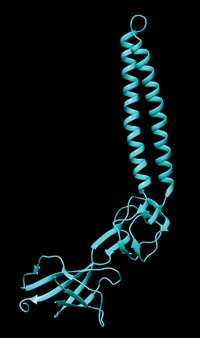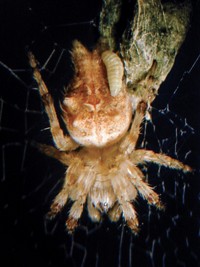Advertisement
Grab your lab coat. Let's get started
Welcome!
Welcome!
Create an account below to get 6 C&EN articles per month, receive newsletters and more - all free.
It seems this is your first time logging in online. Please enter the following information to continue.
As an ACS member you automatically get access to this site. All we need is few more details to create your reading experience.
Not you? Sign in with a different account.
Not you? Sign in with a different account.
ERROR 1
ERROR 1
ERROR 2
ERROR 2
ERROR 2
ERROR 2
ERROR 2
Password and Confirm password must match.
If you have an ACS member number, please enter it here so we can link this account to your membership. (optional)
ERROR 2
ACS values your privacy. By submitting your information, you are gaining access to C&EN and subscribing to our weekly newsletter. We use the information you provide to make your reading experience better, and we will never sell your data to third party members.
Biochemistry
Newscripts
Fungal feuds
by Shi En Kim
March 25, 2023
| A version of this story appeared in
Volume 101, Issue 10
Keanumycins wick away fungal invaders

As John Wick: Chapter 4, the latest installment of Keanu Reeves’s hit-man epic, graced silver screens in the US on March 24, a bacterium that is equal in measure to the movie’s titular character was ruthlessly decimating its enemies. The chemical weaponry it wields is so efficient and deadly that researchers have christened the class of compounds keanumycins.
The label honors Keanu Reeves, an actor who has “played many iconic killers in his cinematic career,” writes chemical biologist Sebastian Götze and colleagues at the Hans Knöll Institute in a study on keanumycins’ antimicrobial properties (J. Am. Chem. Soc. 2023, DOI: 10.1021/jacs.2c11107). Götze discovered the first keanumycin in 2020 and named its family of compounds.
Keanumycins are peptides produced by Pseudomonas bacteria to evade their amoeba predators. While keanumycins are effective amebicides, Götze’s team found that the chemicals also work well against fungal pathogens. In the lab, the researchers observed startling efficiency of keanumycins against the fungus Botrytis cinerea, which instigates gray mold, or Botrytis blight, among greenhouse crops. Nanomolar concentrations of the compound applied to leaves were enough to ward off infection.
Keanumycins lay waste to Botrytis and amoebas by puncturing the cell membranes of its victims, causing them to die a holey death as if riddled with bullet wounds. This Newscriptster would expect nothing less for compounds whose name was inspired by the actor who plays a gun-toting assassin.
In a Reddit Ask Me Anything event, Reeves writes that he’s flattered to be the inspiration behind the name: “Thanks, scientist people!” But he thinks that “they should’ve called it John Wick.”
The researchers love the actor, less so his naming suggestion. Götze tells Newscripts the consonant at the end of John or Wick followed by the letter m of mycin, the parent component of keanumycins’ natural product class, “just doesn’t sound right.” Wickmycin gets stuck on the tongue. Johnmycin doesn’t sound nearly as vicious.
But a keanumycin by any other name would be just as lethal—and useful for combating microbial infections in the real world. Götze’s team is tweaking the chemical structures of keanumycins to improve their pharmacological properties. The researchers are also looking to scale up production for more practical use.
But for the immediate future, they have more urgent plans: one that involves a trip to the cinema during the opening week of John Wick: Chapter 4.
How oyster mushrooms slay

Fungi don’t feast on just the dead and decaying. Several are even carnivorous, snacking on small, live organisms to obtain essential nutrients. The oyster mushroom, which in this Newscriptster’s opinion tastes heavenly when sautéed, is a devilish hunter of nematodes.
If it isn’t yet apparent, it’s kill or be killed in the world of fungi. This time, it’s the oyster mushroom who brandishes toxins to hunt. The chemical it emits is the volatile 3-octanone, which paralyzes its roundworm victim before the nematode dies a grisly death.
In a recent study, researchers in Taiwan and Japan found that Pleurotus ostreatus contains microscopic structures called toxocysts, round sacs that dot the fungus’s filamentous body. They store and concentrate their noxious vapors in one unpleasant punch (Sci. Adv. 2023, DOI: 10.1126/sciadv.ade4809). In the paper, the scientists call this killing strategy “nerve gas in a lollipop.”
Rummaging roundworms that bump into these toxocysts are in for a nasty surprise: First, the released hydrophobic 3-octanone dissolves in the lipid bilayer of their cell membranes and disrupts its integrity. Like a broken hull of a sinking ship, the cell membrane can no longer prevent ions from flooding inside. Swollen with ions, organelles like mitochondria rupture. Neurons, muscle cells, and skin cells die off en masse. Needless to say, death is swift and likely painful.
What happens if we pit the keanumycin- commanding Pseudomonas against the ketone- carrying oyster mushroom? Probably nothing. Götze says that microbes are highly evolved to their habitats and contexts, so any chemical warfare probably won’t spill over to third parties outside immediate predator- prey relationships. Usually.
Please send comments and suggestions to newscripts@acs.org.





Join the conversation
Contact the reporter
Submit a Letter to the Editor for publication
Engage with us on Twitter